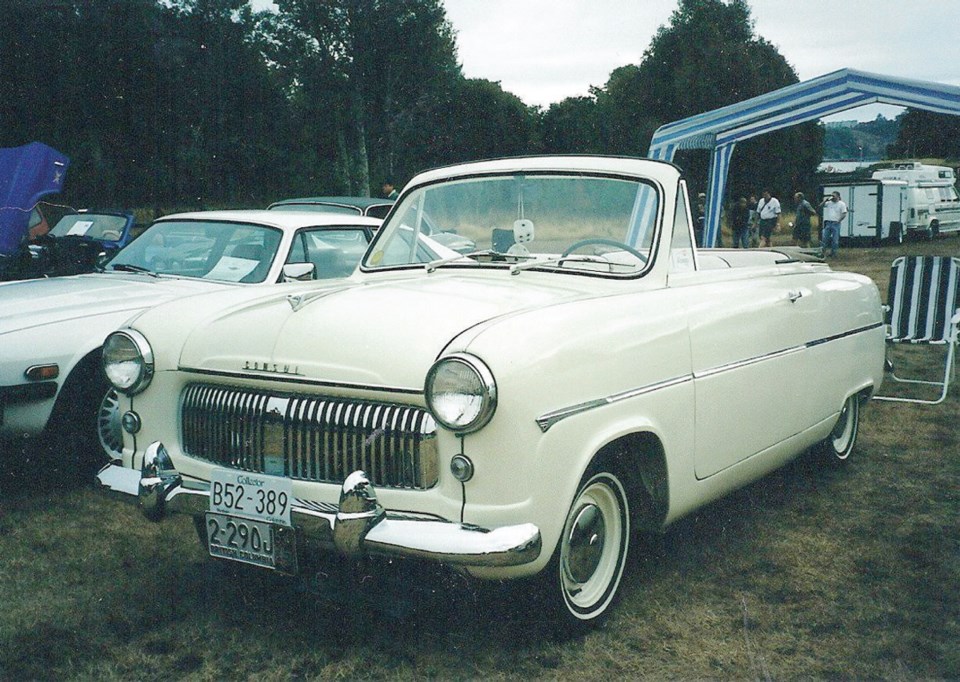Following the Second World War, England began exporting cars, mostly small sedans and sports cars, to North America to earn desperately needed dollars. The English, like Americans, offered slightly modified prewar models until new ones could be developed.
By late 1950, Ford of England’s modern designs were ready, and it introduced its new four-cylinder 1951 Consul followed by the six-cylinder Zephyr. American styling had a strong influence at that time, so it’s not surprising that the Consul/Zephyr came out resembling smaller versions of Ford’s Dearborn models.
The 1951 Consul’s contemporary design featured a notchback envelope body with a one-piece windshield and a fender line that ran level from front to rear. It had a unit-construction body/chassis and an oversquare, overhead-valve 1.5-litre four-cylinder engine.
Performance was modest, although competitive with other contemporary small cars. Road & Track reported that the Consul’s 47 horsepower would push the 1,080-kilogram sedan from zero to 100 km/h in 31.6 seconds and to a top speed of 117 km/h.
The second-generation Consul arrived in 1956 and lasted until 1962. There was also a companion six-cylinder Zephyr and a more deluxe Zodiac. Performance was a little better. Road & Track found the larger 1.7-litre, 59-horsepower Consul four would accelerate it to 100 in 22.5 seconds and reach a top speed of 127 km/h.
The Consul was a practical and economical car, but no more so than several others. Its history would go largely unheralded except for one significant fact: It popularized the MacPherson strut front suspension, a feature that would go on to become the dominant suspension system.
The MacPherson strut was the brainchild of Earle S. MacPherson, a 1915 University of Illinois engineering graduate. He served in both world wars, and his civilian employers included Chalmers Motors, Harley-Davidson, Hupp Motor Car Corp., Pierce-Arrow, Studebaker, General Motors and Ford.
During the Second World War, MacPherson was responsible for all Chevrolet vehicle production. Following the war, General Motors anticipated a market for a light practical car and made MacPherson the chief project engineer. The Chevrolet Cadet, as it was called, reflected his innovative thinking.
To reduce the transmission hump, the Cadet had a small flywheel at each end of the crankshaft. The transmission was under the front seat and the car had independent rear suspension.
Suspension was by MacPherson’s innovative struts. In arriving at the design, he may have been aware of Fiat engineer Fornaca’s 1927 design, or the 1927 French Cottin-Desgouttes “Sans Secousse” (without bumps), which used a vertical steering strut, but with leaf springs, not coils. Also, Morgan and Lancia sliding-pillar-and-coil-spring suspensions could have had an influence, as could the American Christie.
Whether the strut came wholly from MacPherson’s fertile mind or not, it was a masterly piece of engineering. It combined a vertical sliding strut, a steering kingpin and a telescopic shock absorber, with a coil spring encircling the upper end. It combined steering, suspension and damping functions in one sturdy, compact unit.
The top of the strut angled in and was anchored to the car body at a single point. Braking, driving and cornering loads were taken at the bottom of the strut by lateral and longitudinal links.
When the Cadet project was cancelled because it could not meet the $1,000 price target, MacPherson left GM and joined Ford. His strut would appear on French Ford Vedettes and English Fords.
Possibly to distance his design from the GM patent, MacPherson’s Ford struts used the anti-roll bar as a replacement for the lower longitudinal link. This carried simplification even further by combining roll resistance, braking forces and some strut location functions in one component. It was a brilliant stroke.
Although originally used for light cars, the strut could be made sturdy enough for such cars as the BMW 6- and 7-series. The first American use was on the 1978 Ford Fairmont/Mercury Zephyr compacts, although it used a hybrid type with the spring mounted on the lower control arm, not the strut itself.
The MacPherson strut was facilitated by unit construction, because this provided the sturdy upper-body anchor that was required. The compact struts allowed more space for cross-engine layouts and half-shafts, and it proliferated with the popularity of front-drive cars such as the Volkswagen Rabbit and Honda Civic. The strut soon spread through the industry, sometimes with modifications such as a full A-arm at the bottom, which eliminated the need to use the anti-roll bar as a link.
Earle MacPherson’s strut, introduced on those English Fords and the French Vedette, earned an honoured place in automotive engineering history. Unfortunately, MacPherson did not live to see its great popularity. He retired as Ford’s vice-president of engineering in 1958 and died in 1960.
